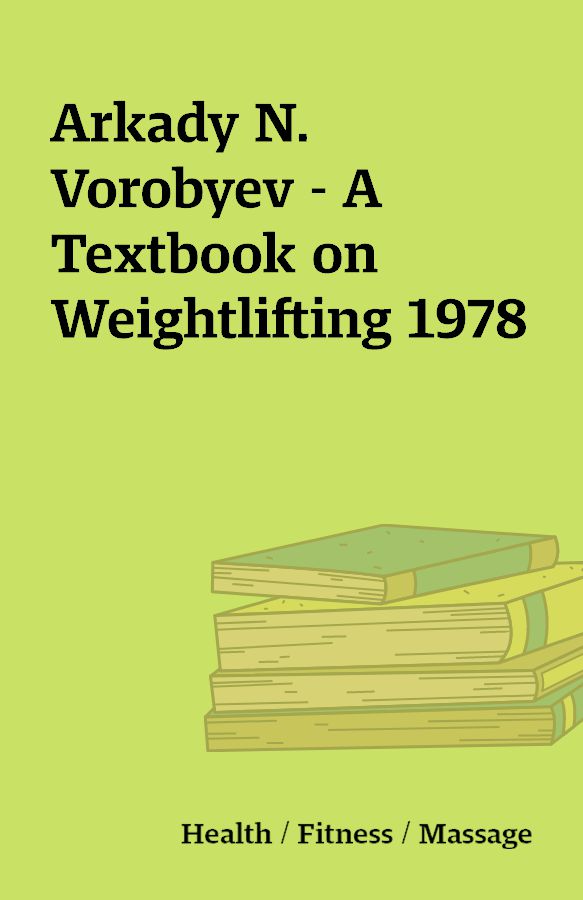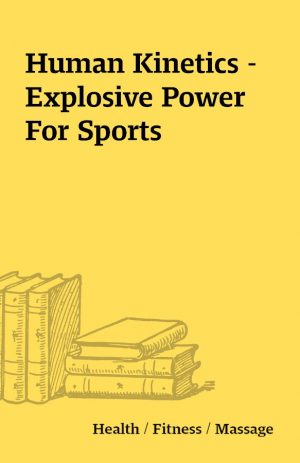Arkady N. Vorobyev – A Textbook on Weightlifting 1978
Arkady.Vorobyev.A.Textbook.on.Weightlifting.pdf
[1 eBook (PDF)]
Description
A Textbook on Weightlifting by Arkady N. Vorobyev, translated by W.J. Brice, 1978This is a elib.tech Exclusive. Leaking it will result in a permanent ban.GB ThreadContributors: nowElite/VIP: 2 weeksPower Users (PU): 2 monthsUsers: neverContentsPreface of the IWF PresidentPreface of the IWF General SecretaryPreface of the IWF Technical Committee PresidentThe AuthorIntroduction0.1. The value of physical education and sport in contemporary society0.2. Characteristics of weightliftingChapter 11.1. Classification and terminology in weightlifting1.2. Terminology in weightlifting1.3. List of basic termsChapter 22.1. Technique of the classical lifts2.2. General bases of technique2.3. The snatch2.4. Starting position2.5. Start at a walk2.6. Grip2.7. Lift to full extension2.8. Split-style snatch2.9. Squat snatch2.10. The clean and jerk2.11. Motor structure of the clean and jerk2.12. Starting position for the clean2.13. The clean2.14. The jerk2.15. Preparatory dip and jerk off2.16. Split and recovery2.17. The relation between body proportions and the technique of the classical lifts2.18. Technique of the performance of the pull by lifters of the three basic types of build2.19. Positioning of the feet2.20. Size of the joint angles at the start2.21. The lfit to the knees2.22. Theoretical and experimental bases of fundamental positions of the technique of the classical lifts2.23. Some general features of the kinetic system of the individual2.24. The understanding of force and movement2.25. The jerk2.26. Trajectory of movement of the bar2.27. Irregularity of movement of the bar2.28. Mistakes encountered in the performance of the classical lifts and their elimination2.29. Mistakes in the snatchChapter 33.1. Specialist-assistance and general development exercises3.2. Specialist-assistance exercises for the snatch3.3. Specialist-assistance exercises for the clean and jerk3.4. Specialist-assistance exercises of general benefit3.5. Exercises in the isometric and concessive regimes of muscular work3.6. Exercises for the development of speed3.7. Exercises for the development of flexibility3.8. Exercises for the development of dexterity3.9. Exercises for the development of special enduranceChapter 44.1. Methods of coaching4.2. Coaching the snatch4.3. Coaching the clean and jerkChapter 55.1. Strength as a motive quality and factors defining it5.2. Relation of muscle strength to weight5.3. ‘Explosive strength’ of muscles5.4. Influence of various factors on the phenomenon of the strength of muscles5.5. Dependence of the strength of muscles on the time of day and year5.6. Influence of hypoxia on the strength of muscles5.7. Influence of ultraviolet radiation on the strength of muscles5.8. Influence of nutrition on muscular strengthChapter 66.1. Training methods6.2. General basis of training6.3. Conduct of sporting training6.4. Volume of load6.5. Month volume of load6.6. Weekly volume of load6.7. Volume of load in weekly cycles6.8. Intensity of load (Average weight of the bar)6.9. Lifting maximum weight6.10. Number of repetitions in a set6.11. Number of exercises in a session6.12. Order of exercises6.13. Tempo of the performance of exercises6.14. Frequency of sessions6.15. Regimes of muscular activity6.16. Isometric method of developing muscular strength6.17. Concessive method of developing muscular strength6.18. ‘Loadless’ method of developing muscular strength6.19. Rest intervals6.20. Specific weight of the classical lifts in training6.21. Specialist assistance exercises in training6.22. Typical schemes for training sessions6.23. Planning of training. The perspective plan6.24. Year plan of training of a qualified lifter6.25. Month plan of training6.26. Warming up for a weightlifter6.27. Exercises for warming up6.28. Special warming up before a contest6.29. Participating in competitions6.30. The development of will-powerChapter 77.1. Features of the practice of weightlifting for youth7.2. Some anatomical-physiological and psychological features of youth7.3. Some features of training methods7.4. Features of the organisation and conduct of competitions for youthChapter 88.1. Health and physiological features of weightlifting8.2. Features of the blood circulation of weightlifters8.3. Respiration8.4. Energy expenditure of weightlifters8.5. Nutrition for weightlifters8.6. Dietary regime8.7. Dietary regime on the day of a competition8.8. Routine for weightlifters8.9. Regulation and reduction of weight8.10. Gaining weight and transfer to a heavier weight category8.11. Emergency increase of weight8.12. Methods for the recovery of the organism after training loads8.13. Massage8.14. Sporting injuries and their prevention8.15. Self-monitoring by weightlifters
You must be logged in to post a review.






Reviews
There are no reviews yet.